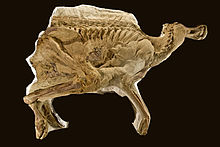
Judith River Formation

The Judith River Formation is a fossil-bearing geologic formation in Montana, and is part of the Judith River Group. It dates to the Late Cretaceous, between 80 and 75 million years ago, corresponding to the 'Judithian' land vertebrate age. It was laid down during the same time period as portions of the Two Medicine Formation of Montana and the Oldman Formation of Alberta.It is an historically important formation, explored by early American paleontologists such as Edward Drinker Cope, who named several dinosaurs from scrappy remains found here on his 1876 expedition (such as Monoclonius). Modern work has found nearly complete skeletons of the hadrosaurid Brachylophosaurus.HabrosaurusH. dilatusA siren.LisserpetonL. bairdiA scapherpetonid salamander.OpisthotritonO. kayiA possible lungless salamander.ProdesmodonP. copeiA lungless salamander.ScapherpetonS. tectumA scapherpetonid salamander.BelonostomusBelonostomus longirostrisKindleiaK. fragosaLepisosteusL. occidentalis?Paralbula?P. sp.A bonefish.MyledaphusM. bipartitusA stingray.AlbertaceratopsA. nesmoiReclassified as Medusaceratops lokiiAvaceratopsA. lammersi' partial skulls, skeleton, juvenile,' type specimenA ceratopsidBrachylophosaurusB. canadensisA hadrosauridCeratopsC. montanus'occipital condyle, paired horn cores,' type specimenA dubious ceratopsidDicloniusD. calamarius'Teeth.'Nomen dubiumD. pentagonius'Fragmentary dentary with teeth,' type specimenA dubious hadrosauridD. perengulatus'Teeth.'Nomen dubiumDysganusD. bicarinatus'Isolated teeth.'Nomen dubiumD. encaustus'Single tooth and tooth fragments.' 'Isolated teeth.'Nomen dubiumD. haydenianus'Isolated teeth.'Nomen dubiumD. peiganus'Tooth.'Nomen dubiumHadrosaurusH. paucidensReclassified as Lambeosaurus? paucidensJudiceratopsJ. tigrisA ceratopsid?'Kritosaurus'?'K.' brevicepsA hadrosaurid?Lambeosaurus?L. paucidens'Squamosal, maxilla.'A hadrosauridMedusaceratopsM. lokiiBonebedA ceratopsidMercuriceratopsM. gemini'one apomorphic squamosal'A ceratopsidMonocloniusM. crassus' skulls, complete.' Type specimenA dubious ceratopsidPaleoscincusP. costatus'Tooth,' type specimenA dubious ankylosaurProbrachylophosaurusP. bergeiA brachylophosaurin hadrosaurPteropelyxP. grallipes'Skeleton lacking skull.'A dubious hadrosauridTrachodonT. mirabilisIsolated teeth, type specimenA dubious hadrosauridChampsosaurusC. sp.BrachychampsaB. montanaLeidyosuchusL. canadensisChamopsC. segnisExostinusE. lancensisA knob-scaled lizard.LeptochamopsL. denticulatusA whiptail.ParadermaP. bogertiA parasaniwid.ParasaniwaP. wyomingensisA parasaniwid.AublysodonA. lateralis'Isolated teeth,' type specimenJunior synonym of Deinodon horridusA. mirandusTeeth, type specimenPossible junior synonym of Deinodon horridusHesperornisH. altusPartial tibiotarsusOne of the only known freshwater occurrences of a hesperornithid.DeinodonD. falculusTeethIsolated tyrannosaur teeth classified in the dubious genus DeinodonD. hazenianusTeethJunior synonym of Deinodon horridusD. horridus'Teeth,' type specimenIsolated tyrannosaur teeth that formed the basis of the dubious genus DeinodonD. incrassatusTeethJunior synonym of Deinodon horridusD. lateralisJunior synonym of Deinodon horridusDromaeosaurusD. albertensisTeethA dromaeosaurid, also found in the Dinosaur Park FormationD. explanatus'Tooth.'Possible relative of SaurornitholestesD. laevifrons'Tooth.'Possible relative of SaurornitholestesOrnithomimusO. tenuis'Fragmentary metatarsal.'A possible troodontid or juvenile tyrannosauridParonychodonP. lacustrisTeeth, type specimenAn indeterminate maniraptoran, also found in the Dinosaur Park, Milk River, and Kirtland FormationsTroodonT. formosusTeeth (type specimen), vertebra, eggA troodontid, also found in the Oldman and Two Medicine FormationsZapsalisZ. abradens'Teeth,' type specimenA dromaeosauridBasilemysB. sp.A Mesoamerican river turtle. The Judith River Formation is a fossil-bearing geologic formation in Montana, and is part of the Judith River Group. It dates to the Late Cretaceous, between 80 and 75 million years ago, corresponding to the 'Judithian' land vertebrate age. It was laid down during the same time period as portions of the Two Medicine Formation of Montana and the Oldman Formation of Alberta.It is an historically important formation, explored by early American paleontologists such as Edward Drinker Cope, who named several dinosaurs from scrappy remains found here on his 1876 expedition (such as Monoclonius). Modern work has found nearly complete skeletons of the hadrosaurid Brachylophosaurus. The Judith River Formation is composed of mudstone, siltstone and sandstone. Coal beds, bentonite and coquinas are also observed. The Judith River Formation conformably overlies the Claggett Formation and Pakowki Formation. It is overlain by the Bearpaw Formation. It is equivalent to the Belly River Formation in the southern Canadian Rockies foothills, the Lea Park Formation in central Alberta and the Wapiti Formation in the northwestern plains. The Birch Lake Member and Ribstone Creek Member are sandstone units recognized inside the Judith River Formation. Other informal subdivisions include the Brosseau Member and Victoria Member, which are considered obsolete due to their inconsistent lateral distribution. Faunal list follows a review published by Ashok Sahni in 1972 unless otherwise noted. There are three potential species of discoglossid frogs. Hip bones, possibly representing a North American member of the European spadefoot toad family are also known from the formation. An unnamed tyrannosaurine is known from the formation.
